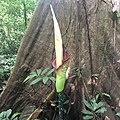| Image | Name | Year | Distribution |
|---|
| Amorphophallus adamsensis Magtoto, Mones, Ballada, Austria, R.M.Dizon, Alangui, Regina | 2013 | Philippines |
| Amorphophallus angulatus Hett. & A.Vogel | 1994 | Borneo (Sarawak) |
| Amorphophallus ardii [15] Yuzammi & Hett. | 2020 | Sulawesi |
| Amorphophallus asper (Engl.) Engl. & Gehrm. | 1911 | Sumatera |
| Amorphophallus bangkokensis Gagnep. | 1941 | Thailand |
| Amorphophallus beccarii Engl. | 1880 | Sumatera |
| Amorphophallus borneensis (Engl.) Engl. & Gehrm. | 1911 | Borneo |
| Amorphophallus boyceanus Hett. | 2001 | Thailand and Peninsular Malaysia |
| Amorphophallus brachyphyllus Hett. | 2001 | Borneo (Kuching) |
| Amorphophallus bufo Ridl. | 1909 | Malaysia |
| Amorphophallus calcicolus Tamayo MN, Magtoto LM, Sumalinog MS, Reyes TD, Austria CM | 2021 | Philippines |
| Amorphophallus caudatus Bustamante et al. | 2020 | Philippines |
| Amorphophallus cidarioides J.R.Callado, Medecilo & Hett. | 2020 | Philippines |
 | Amorphophallus commutatus (Schott) Engl. | 1879 | Western India |
| Amorphophallus costatus Hett. | 1994 | Borneo (Sarawak, Kalimantan) |
| Amorphophallus declinatus Hett. | 1994 | Philippines |
 | Amorphophallus decus-silvae Backer & Alderw. : West-Java giant amorphophallus | 1920 | Java |
| Amorphophallus discophorus Backer & Alderw. | 1920 | Java |
| Amorphophallus eburneus Bogner | 1989 | Borneo (Sarawak) |
| Amorphophallus elegans Ridl. | 1922 | Peninsular Malaysia |
| Amorphophallus flammeus Calaramo, Batuyong, Bulawin & Alejandro | 2022 | Philippines |
| Amorphophallus fontarumii N F. Bulawin, M P. Medecilo-Guiang, Grecebio J. D. Alejandro | 2022 | Philippines (Luzon) |
| Amorphophallus forbesii (Engl.) Engl. & Gehrm. | 1911 | Sumatra |
| Amorphophallus fornicatus Hett., J.R.C.Callado & Wistuba | 2020 | Philippines (Luzon) |
 | Amorphophallus galbra F.M.Bailey | 1893 | New Guinea to N. Australia |
 | Amorphophallus gigas Teijsm. & Binn.: Sumatra giant amorphophallus | 1862 | Sumatra |
 | Amorphophallus hewittii Alderw. | 1920 | Borneo |
| Amorphophallus hirsutus Teijsm. & Binn. | 1862 | Nicobar Islands, W. Sumatra |
| Amorphophallus hottae Bogner & Hett. | 1992 | Borneo (Sabah, Sarawak) |
| Amorphophallus infundibuliformis Hett., A.Dearden & A.Vogel | 1994 | Borneo |
| Amorphophallus julaihii Ipor, Tawan & P.C.Boyce | 2004 | Borneo (Sarawak) |
| Amorphophallus juliae P.C.Boyce & Hett. | 2010 | Borneo (Sarawak) |
| Amorphophallus koratensis Gagnep. | 1941 | Cambodia, Laos, Thailand |
| Amorphophallus lambii Mayo & Widjaja | 1982 | Borneo |
| Amorphophallus linguiformis Hett. | 1994 | Borneo (Kalimantan) |
 | Amorphophallus longispathaceus Engl. & Gehrm. | 1911 | Philippines (Mindanao) |
| Amorphophallus longistylus Kurz ex Hook.f. | 1893 | Andaman Islands. |
| Amorphophallus luzoniensis Merr. | 1915 | Philippines (Luzon) |
| Amorphophallus malkmus-husseinii A.Galloway, Prehsler & Claudel | 2019 | Laos |
| Amorphophallus manta Hett. & Ittenbach | 1994 | Sumatra to Peninsula Malaysia |
| Amorphophallus merrillii K.Krause | 1912 | Philippines |
| Amorphophallus minimus R.Bustam., C.Claudel & M.N.Tamay | 2021 | Philippines |
| Amorphophallus minor Ridl. | 1904 | Peninsula Malaysia |
| Amorphophallus myosuroides Hett. & A.Galloway | 2006 | Laos |
| Amorphophallus niahensis P.C.Boyce & Hett. | 2010 | Borneo (Sarawak) |
| Amorphophallus obovoideus Alderw. | 1922 | Sumatra |
| Amorphophallus obscurus Hett. & Sizemore | 2001 | Thailand |
| Amorphophallus ongsakulii Hett. & A.Galloway | 2006 | Laos |
| Amorphophallus opertus Hett. | 1994 | Vietnam |
 | Amorphophallus paeoniifolius (Dennst.) Nicolson: Whitespot giant arum, elephant yam | 1977 | Andaman Island, Assam, Bangladesh, Borneo, Cambodia, China South-Central, China Southeast, East Himalaya, Hainan, India, Java, Laos, Lesser Sundas Is., Malaya, Maluku, Myanmar, New Guinea, Northern Territory, Philippines, Sri Lanka, Sulawesi, Sumatra, Taiwan, Thailand, Vietnam |
| Amorphophallus palawanensis Bogner & Hett. | 1992 | Philippines |
| Amorphophallus pendulus Bogner & Mayo: Brunei amorphophallus | 1986 | Borneo (Brunei, Sarawak) |
| Amorphophallus plicatus Bok & H.J.Lam | 1936 | Sulawesi |
| Amorphophallus polyanthus Hett. & Sizemore | 2001 | Thailand |
 | Amorphophallus prainii Hook.f. | 1893 | Laos, Malaya, Sumatera, Thailand |
| Amorphophallus pulchellus Hett. & Schuit. | 2013 | Laos |
| Amorphophallus pusillus Hett. & Serebryanyi | 1994 | Vietnam |
| Amorphophallus ranchanensis Ipor, A.Simon & Meekiong | 2007 | Borneo (Sarawak) |
| Amorphophallus rayongii Hett. & Medecilo | 2020 | Philippines |
| Amorphophallus rostratus Hett. | 1994 | Vietnam |
| Amorphophallus rugosus Hett. & A.Lamb | 1994 | Borneo (Sabah) |
| Amorphophallus sagittarius Steenis | 1953 | Java |
| Amorphophallus salmoneus Hett. | 1994 | Philippines |
| Amorphophallus scaber Serebryanyi & Hett. | 1994 | Philippines |
| Amorphophallus serrulatus Hett. & A.Galloway | 2006 | Thailand |
| Amorphophallus spectabilis (Miq.) Engl. | 1879 | Java |
| Amorphophallus sumawongii (Bogner) Bogner & Mayo | 1985 | Thailand |
| Amorphophallus terrestris Hett. & Claudel | 2012 | Thailand |
| Amorphophallus tinekeae Hett. & A.Vogel | 2001 | Borneo |
 | Amorphophallus titanum (Becc.) Becc. ex Arcang: Titan arum, krubi (largest flower structure on earth) | 1879 | Sumatra |
| Amorphophallus urceolatus Hett., A.Galloway & Medecilo | 2020 | Philippines |
 | Amorphophallus variabilis Blume | 1873 | Jawa to Lesser Sunda Islands, Philippines |
| Amorphophallus venustus Hett., A.Hay & Mood | 2001 | Borneo |
| Amorphophallus verticillatus Hett. | 1994 | Vietnam |
| Amorphophallus yaoi Hett., A.Galloway & Medecilo | 2020 | Philippines |
| Amorphophallus samarensis Fontarum-Bulawin, Medecilo-Guiang & Alejandro. | 2024 | Philippines |
|



























